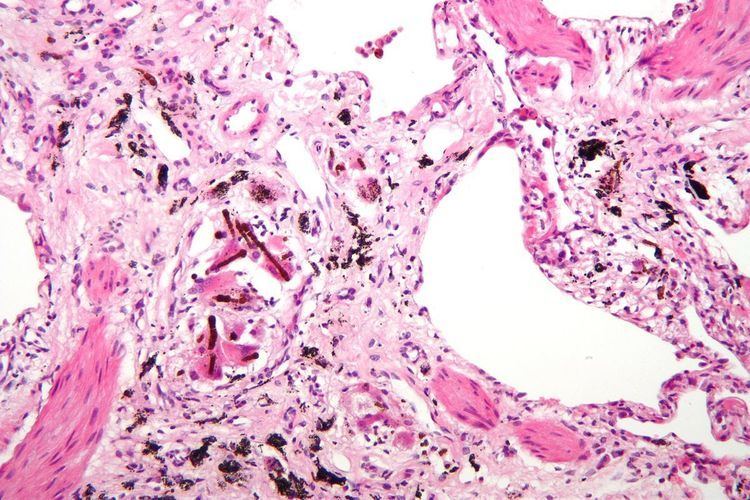Specialty pulmonology ICD-9-CM 500-505 MeSH D011009 | ICD-10 J60-J65 DiseasesDB 31746 | |
 | ||
Pneumoconiosis is an occupational lung disease and a restrictive lung disease caused by the inhalation of dust, often in mines and from agriculture.
Contents
In 2013 it resulted in 260,000 deaths up from 251,000 deaths in 1990. Of these deaths 46,000 were due to silicosis, 24,000 due to asbestosis and 25,000 due to coal workers pneumoconiosis.
Types
Depending upon the type of dust, the disease is given different names:
Pathogenesis
The reaction of the lung to mineral dusts depends on many variables, including size, shape, solubility, and reactivity of the particles. For example, particles greater than 5 to 10 μm are unlikely to reach distal airways, whereas particles smaller than 0.5 μm move into and out of alveoli, often without substantial deposition and injury. Particles that are 1 to 5 μm in diameter are the most dangerous, because they get lodged at the bifurcation of the distal airways. Coal dust is relatively inert, and large amounts must be deposited in the lungs before lung disease is clinically detectable. Silica, asbestos, and beryllium are more reactive than coal dust, resulting in fibrotic reactions at lower concentrations. Most inhaled dust is entrapped in the mucus blanket and rapidly removed from the lung by ciliary movement. However, some of the particles become impacted at alveolar duct bifurcations, where macrophages accumulate and engulf the trapped particulates. The pulmonary alveolar macrophage is a key cellular element in the initiation and perpetuation of lung injury and fibrosis. Many particles activate the inflammasome and induce IL-1 production. The more reactive particles trigger the macrophages to release a number of products that mediate an inflammatory response and initiate fibroblast proliferation and collagen deposition. Some of the inhaled particles may reach the lymphatics either by direct drainage or within migrating macrophages and thereby initiate an immune response to components of the particulates and/or to self-proteins that are modified by the particles. This then leads to an amplification and extension of the local reaction. Tobacco smoking worsens the effects of all inhaled mineral dusts, more so with asbestos than with any other particle.
Diagnosis
Positive indications on patient assessment:
Pneumoconiosis in combination with multiple pulmonary rheumatoid nodules in rheumatoid arthritis patients is known as Caplan's syndrome.
Epidemiology
In 2013 pneumoconiosis resulted in 260,000 deaths up from 251,000 deaths in 1990. Of these deaths 46,000 were due to silicosis, 24,000 due to asbestosis and 25,000 due to coal workers pneumoconiosis.
